Most of the forestry I see in southern Vermont can be characterized as “hunter-gatherer” forestry: the only management activity is timber harvesting, and harvesting is only done when it is profitable. In effect, stands that can be profitably harvested are “hunted,” and the timber is gathered. There may be activities associated with the harvest that cost money, such as invasive plant control, cutting of unmerchantable trees, and road and landing construction, but the overall mindset of most foresters and landowners seems to be that every entry must generate more money than it costs. In my travels, it appears this practice is common throughout the Northeast.
One consequence of hunter-gatherer forestry is that management activities are based on existing trees, not on the potential of the land to grow trees. Thus, an area dominated by multi-stemmed, weevilled white pine may be left standing, as it would be expensive to harvest and yield little merchantable product. Similarly, an area of degenerate hardwoods would likely be seen as not worth harvesting. Since low-quality trees rarely improve with age, these areas won’t see any management work in the future, either.
Another consequence of hunter-gatherer forestry is that stands have to reach large pole/small sawlog size (generally 8 to 12 inches in diameter at breast height) before the first logging is done, because smaller trees generally cost more to harvest than the wood is worth. That means that many stands go unmanaged for the 50 or more years it takes for the trees to reach this size. During this time, the vast majority of the tree seedlings that nature has planted will have died, so we may well have lost the opportunity to select desired species. The trees that do survive will typically have small crowns and will respond slowly to a thinning and have an increased risk of epicormic branching. Not investing early in a stand’s management means that opportunities to decide on the species composition of the stand – and to increase growth rates dramatically – have been lost.
Intensive Forest Management
I believe that we are missing out on the advantages of more intensive forest management. In other parts of our country and the world, significant investments are made – including site preparation, planting, thinning, and protection – decades before trees are harvested. Perhaps because we live in a part of the world where forests come back on their own, we’ve adopted the mentality that little or no investment is needed to grow trees.
In an “intensive forest management” regimen, the goal is to grow quality trees of desired species rapidly. The timeframe is still multigenerational, but areas that would have been avoided in hunter-gatherer forestry are actively managed.
If the objective is growing quality sawlogs, foresters concentrate on growing high-value species with clear lower trunks. If the goal is to promote wildlife species that depend on mast crops, then beech and oaks are favored. Diversity is an important consideration in determining desired species, as diverse forests are more resilient in the face of threats than are monocultures. Another tenet of intensive forest management is to grow species that are well adapted to the soils, water conditions, and microclimate on a given site; for instance, sugar maple and cherry like well-drained soil, and eastern hemlock does well in deep ravines and on north-facing slopes.
Climate change is a new factor to consider in deciding on the desired species. Given that trees can live for 100 years or more, it behooves us to think of the climate they will experience in the coming decades. Climate models for the Northeast predict that we’ll experience warmer temperatures and more precipitation but with greater variability, so this may include more droughts. For southern Vermont, this suggests that white pine and red oak are species to favor, as they are relatively drought- and heat-tolerant compared to sugar maple and yellow birch.
As we identify our quality trees, it’s important to assess their growth, since rapidly growing trees have several distinct advantages over slowly growing ones. They are better able to defend against insects, disease, and decay organisms. When they are injured, they grow over wounds more quickly, decreasing the chance of infection. They produce more seeds – generally at an earlier age – which benefits both wildlife and forest regeneration. And fast-growing trees yield valuable forest products much sooner than do trees that grow slowly.
Of course, most trees do not grow in diameter at a uniform rate throughout their lives. It is not uncommon for a tree to grow rapidly in its early years before slowing as it becomes crowded by neighbors. Similarly, a crowded tree may respond to release from the competition of neighboring trees by growing more rapidly, with growth rates doubling or tripling within the space of a few years.
This potential increase in growth rates in trees following their release from competition is a very important consideration. In general, young trees are far better at responding to release than older ones. As trees grow older (as a percentage of their species’ typical lifespan), they generally are less able to respond to release. (A possible exception is eastern hemlock, which seems to respond at any age.) So early intervention is preferable.
What Intensive Forest Management Looks Like
The first step is to assess the trees and the site. What’s the species composition? Are the trees of good quality? How rapidly are they growing? How old are they? Are the soils capable of growing quality trees? Is the area accessible and amenable to harvesting? Only then is it possible to know if the best of the current trees are worth growing or if it is time to plan for regeneration. If there are enough trees worth growing, then thinning, crop-tree release, or individual tree selection methods can be used. If it is time to start over again and regenerate the stand, then patch cuts, shelterwood, seed tree, and clearcutting are options.
In my work, I’ve found that if we intercede early enough, we can change the species composition in a forest stand. For example, white pine usually out-competes hardwoods only in abandoned fields or on excessively well-drained soils. Since pine seedlings spend their first few years growing slowly, they are easily overtopped by hardwoods on most soils. Once they become well established, however, the pines can grow three or more feet in height per year and compete well with hardwoods. Therefore, where nature has planted a mix of white pine and hardwoods, we can keep much more pine for the future if we release the pine seedlings.
We can also improve the quality of the trees for future forest products with early intervention. Most of the value of a tree is in the first log – the first 16 feet. By choosing to retain straight seedlings and saplings that don’t have forks, we can dramatically increase the value of the future logs. Pruning the best of the trees at an early age will yield the most prized logs.
And we can dramatically increase the growth rate of the young trees by releasing them from competition. Instead of letting spindly trees grow in “dog-hair” stands, we can have robust seedlings and saplings, which gain significant girth as they reach for the sky.
I’ve learned that it makes sense to do the first thinning of dense regeneration when the tallest seedlings are knee-high to chest-high. At this height, I can look down on the trees and quickly determine which ones are of the most desirable species and form. With a clearing saw – essentially a heavy duty weed-whacker equipped with a saw blade – I can generally selectively thin an acre or more per day, with the cut seedlings easily falling to the ground. I also evaluate stump sprouts, keeping one per stump if they are of a desired species and form.
I take a cue from prescribed planting rates in determining the spacing for these little seedlings. When planting, foresters often specify around 500 trees per acre, or a spacing of something like 8 feet by 10 feet. I hedge my bets, generally spacing the seedlings about five feet apart. This is far enough apart that they will readily fall when I come back to thin again in two to four years, and I will have many options to choose from at the next entry.
If I wait until the seedlings are taller – say saplings 10 to 15 feet in height – the work becomes harder and it takes days rather than hours per acre to thin if the saplings are dense. For spacing, my cue is that if the saplings won’t readily fall when cut, I need to space the save trees farther apart. Note that at a growth rate of three feet per year, it takes but two or three years for the job to go from fast, easy work to difficult, time-consuming work. And if I wait until the trees are 20 or 25 feet tall, then I need to use a chainsaw to section many of the trees that I fell.
Frequent thinning not only makes the job easier, but it helps the trees maintain a high average-diameter growth rate. If the crowns are close to touching, it is time for the next entry. Timing is everything!
Is Intensive Forest Management Worth Doing?
Trees can grow at impressive rates. I’ve seen white pines put on one inch in diameter over a year. One of the white ash boards in the top of my dining-room table has four rings per inch, indicating that it came from a tree growing half-an-inch in diameter every year. While these growth rates are exceptional, careful management with frequent releases of the best trees can result in far faster growth than occurs in a more crowded forest.
Is it worth doing this intensive management versus doing hunter-gatherer forestry? You’ll have to consider the finances. The release of young trees described above, likely done a few times before trees reach merchantable size, is a lot of work. For landowners paying to have this work done, the costs per acre can be significant. Projecting the value of this money into the future and looking at the financial returns gives an idea of whether the investment is worthwhile. Many assumptions are needed to make such computations, including likely growth rates and the future value of logs. Research by Dr. Bob Seymour at the University of Maine into intensively growing white pine suggests that reasonable returns on investment are indeed quite plausible. Since ownership tenure is generally shorter than a crop tree’s life, the increased value of land with quality trees growing on it may be a consideration.
But money is not the only factor. If one views the forest resource as infinite, then hunter-gatherer forestry makes lots of sense: when the desirable trees in one area are used up, simply move to another. Indeed, this has been the history of timber harvesting in our country, with the loggers and mills moving westward as forestland was cut over. We now know that the forest resource is far from infinite, and that the volume and quality of forest products (everything from wood to clean water and air to wildlife to recreational opportunities) depends in large part on how we manage the forests. While each landowner’s actions are tiny in view of the whole resource, collectively we determine how well a larger forest is managed.
I gain immense satisfaction from watching the changes that result from my management activities. Knee-high seedlings tower over me in 10 years. Sawlog-sized trees grow noticeably in a similar time frame. The snowshoe hare population increases as young trees become more common. Bird diversity has increased dramatically. These are among the rewards that I reap from intensively managing my woodlot; it doesn’t matter that I won’t live long enough to see today’s seedlings become forest giants.
I pursue intensive forest management on my woodlot for all these reasons. I’ve learned from experience that it is not worth it to grow trees slowly – it takes too long, and they are too likely to succumb or produce low-quality logs. In refining these techniques, I’ve been amazed at how quickly trees can grow, and I enjoy the work and challenges of helping them reach their potential.
How Growth Rate Translates Into Actual Growth
We can learn a lot about a tree’s history by examining its growth rings. The rings can tell us how many years a tree has been growing (simply count the rings), but also the rate at which that growth is occurring (a wider ring indicates more growth in a given year, a tighter ring less growth). The easiest way to inspect growth rings is on a stump, or better yet on the butt-end of the first log. (Stumps tend to flair, which can distort the rings.) You can get a look at the rings in a standing tree, though, by using a tool, called an increment borer, which allows you to drill into a tree stem and extract a small core.
The table above shows how this data on past growth can be used to project future tree growth. The top, horizontal row denotes the tree’s average growth rate as expressed in rings per inch – you’d get this number from your core or your stump. The vertical row on the left denotes elapsed time measured in years. The numbers in the body of the chart express diameter growth in inches. Thus, if we took a core from a hypothetical 10-inch ash tree, and found that the tree was growing at an average of 30 rings per inch, we could calculate that in 10 years we could expect an additional 0.7 inches of growth. Follow that column all the way to the bottom and we see that it would take a century for the tree to put on an additional 6.7 inches of growth. If your target diameter is 18 inches, the tree would still not have attained it. Conversely, if the same tree were growing at a rate of 8 rings per inch, in 10 years it should have put on 2.5 inches of growth. At that rate, in 30 years the same 10-inch ash will have put on 7.5 inches and become a 17.5-inch ash, a point at which the tree is just about ready for harvest. Of course, factors such as the availability of sunlight and water, extreme weather events, and disease outbreaks can affect the growth rate and, thus, alter the ultimate results.


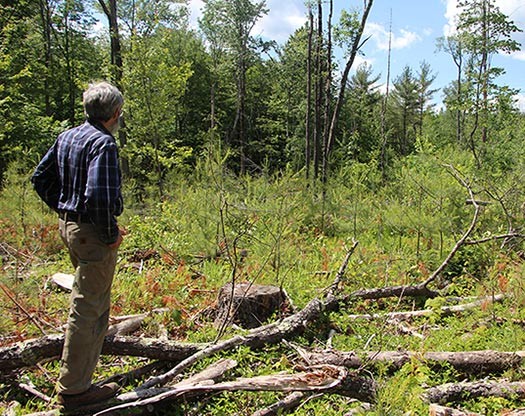

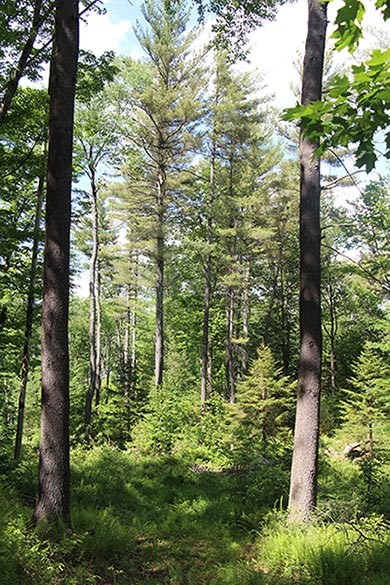



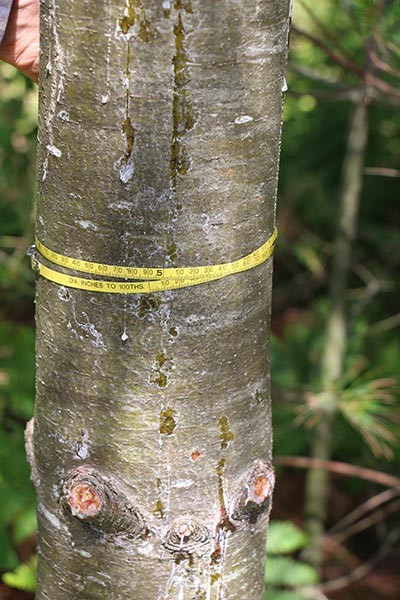
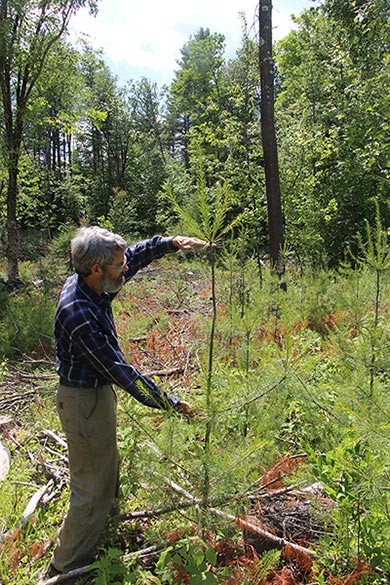
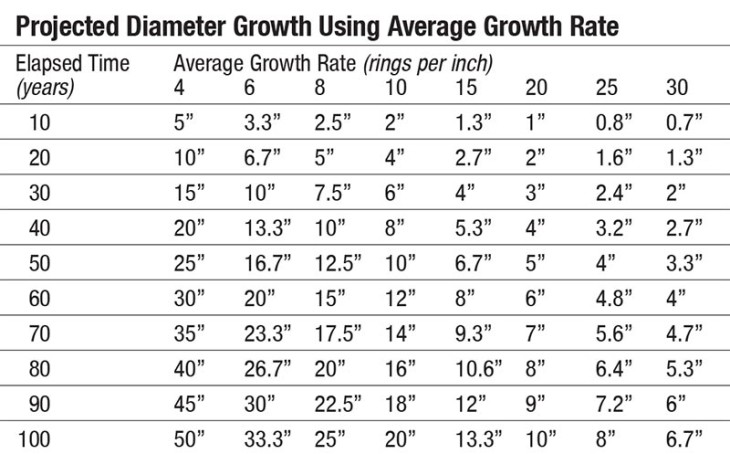
Discussion *